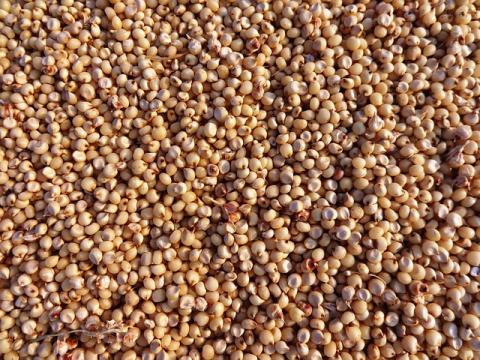
Sorghum is native to Sub-Saharan Africa and was first harvested in the Nile River basin approximately 7000 years ago. It became a crop in India around 3000 B.C.E. and found its way east by way of the Silk Road. It was brought to Rome from India in approximately 60 C.E., then to Spain and finally Europe in the 12th Century. Benjamin Franklin introduced the plant to North America and it eventually became a major crop. It is a grass with thirty varieties of the plant but only one is used for human consumption. It is the primary ingredient in sorghum molasses and is a staple food throughout the world. It is also considered one of the most beneficial foods to maintain health and prevent disease. Ayurveda uses it for Kapha dosha and it is a holistic healing food. Sorghum is rich in vitamins and minerals with high content of niacin, riboflavin and thiamin, as well as calcium, copper, iron, phosphorous and potassium. One serving provides approximately half of the daily requirement of protein and it has a high fiber content.
Here are 5 reasons to get more sorghum in your diet:
1. The fiber content of sorghum makes it a beneficial food for the digestive system; one serving contains forty-eight percent of the recommended daily intake of fiber. This helps with the food through the digestive tract and prevents bloating, constipation, cramping, diarrhea, excess gas and stomach aches. It also helps the body to scrape away bad cholesterol, reducing the risk of atherosclerosis, heart attacks and strokes.
2. Sorghum benefits the circulatory system because of its copper and iron content. Copper helps the body absorb iron, reducing the development of anemia. It also increases the production of red blood cells, and thus, increases blood circulation, which stimulates cellular growth and maintenance. It boosts energy levels and increases hair growth.
3. Containing significant amounts of magnesium, sorghum maintains healthy levels of calcium in the body and increases the body’s absorption of calcium. Proper levels of these two minerals are essential for bone health and the maintaining of bone tissue, as well as a strong skeletal system. It reduces the risk of osteoporosis and arthritis and speeds up healing of the bone tissue.
4. Sorghum is an excellent food to reduce the risk of cancer. The bran layer of the grain contains antioxidants that are missing in many other fiber foods. (Antioxidants are compounds that neutralize and eliminate free radicals in the body which cause healthy cells to mutate into cancer cells.)
5. The tannin rich bran of sorghum grains contains enzymes that inhibit the absorption of starch by the body. This is essential to keeping the sugar levels of the body in balance, and is therefore an excellent food for those suffering with diabetes. Sorghum reduces the risks of spiking and ebbing of insulin in glucose levels, thus preventing diabetic shock and complications that it can cause.
Sorghum is a safe and nutritious food to add to the diet. It can be used as flour, in soups, as a side dish and is a very versatile ingredient in many recipes. While a major livestock feed crop, this ancient food is slowly becoming popular in the United States as a new ingredient in recipes and can be found in bulk and packaged at most health food stores.








